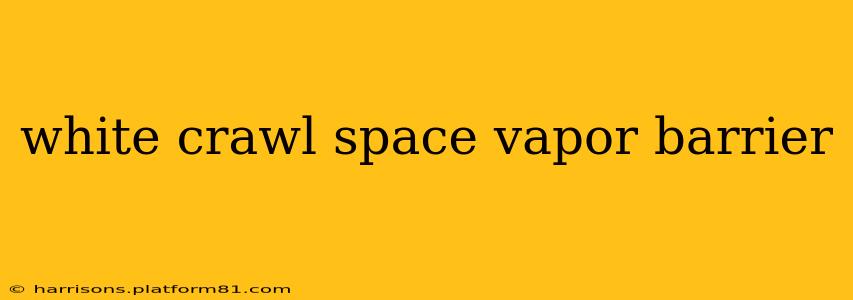A crawl space vapor barrier is crucial for protecting your home's foundation and indoor air quality. Choosing the right material, understanding installation, and knowing the benefits are key to a successful project. This guide will explore everything you need to know about white crawl space vapor barriers, focusing on their advantages and addressing common questions.
Why Choose a White Crawl Space Vapor Barrier?
White vapor barriers, often made of polyethylene plastic sheeting, offer several key advantages over other materials:
- Reflectivity: The white color reflects sunlight, reducing heat buildup in the crawl space, thus lowering energy costs and improving the overall comfort of your home. Darker materials absorb heat, potentially leading to moisture problems.
- Cost-Effectiveness: Polyethylene sheeting is generally a cost-effective solution compared to more specialized vapor barrier materials.
- Ease of Installation: For DIYers, polyethylene sheeting is relatively easy to install, although professional installation is always recommended for optimal results.
- Moisture Control: The primary function of any vapor barrier is to prevent moisture from entering the crawl space. A properly installed white polyethylene barrier effectively blocks moisture, protecting your home’s structural integrity.
What are the Different Types of Crawl Space Vapor Barriers?
While white polyethylene is common, several other vapor barrier options exist:
- Polyethylene: This is the most common and affordable option, available in various thicknesses. Thicker sheeting provides better protection.
- Visqueen: A brand name often associated with polyethylene sheeting, known for its reliability and moisture resistance.
- Reflective Foil: These materials incorporate a foil layer to reflect radiant heat, offering additional insulation benefits. However, they're typically more expensive than polyethylene.
How Much Does a White Crawl Space Vapor Barrier Cost?
The cost varies significantly depending on the size of your crawl space, the type of material chosen, and whether you opt for professional installation. Expect to pay anywhere from a few hundred dollars for smaller spaces and DIY installation to several thousand dollars for larger spaces and professional services.
How to Install a White Crawl Space Vapor Barrier?
Proper installation is crucial for effectiveness. Here's a simplified overview (professional installation is highly recommended):
- Preparation: Clean the crawl space thoroughly, removing debris and leveling the ground.
- Overlap and Sealing: Overlap sheets by at least 6 inches and seal the seams with vapor-barrier tape. Thorough sealing prevents moisture penetration.
- Wall Coverage: Extend the barrier up the walls to prevent moisture wicking.
- Ventilation: Ensure adequate ventilation remains after installation to prevent moisture buildup.
What are the Benefits of a Crawl Space Vapor Barrier?
Numerous benefits result from installing a vapor barrier:
- Protection against Mold and Mildew: A barrier significantly reduces moisture, preventing the growth of mold and mildew, which can cause health problems and structural damage.
- Improved Indoor Air Quality: By controlling moisture, the barrier reduces the potential for mold spores and allergens to enter your living space.
- Increased Energy Efficiency: By reducing heat transfer, the barrier can contribute to better insulation and lower energy bills.
- Extended Lifespan of Your Home: Protecting your foundation from moisture prolongs the lifespan of your home, saving you significant costs in repairs down the line.
How Long Does a White Crawl Space Vapor Barrier Last?
With proper installation and maintenance, a high-quality polyethylene vapor barrier can last for many years, often 10-20 years or more. However, periodic inspection is essential to ensure its integrity and address any damage.
Can I Install a Vapor Barrier Myself?
While DIY installation is possible, especially with polyethylene sheeting, it's often recommended to hire a professional. Professional installers have the experience to ensure proper installation, avoiding common mistakes that can compromise the barrier's effectiveness.
What is the best thickness for a crawl space vapor barrier?
The ideal thickness depends on several factors, including the climate and the level of moisture in your crawl space. Thicker barriers generally offer better protection, but they also come at a higher cost. Consult with a professional to determine the appropriate thickness for your specific situation.
This comprehensive guide provides a strong foundation for understanding white crawl space vapor barriers. Remember, proper installation is key to maximizing their benefits. For complex situations or larger projects, professional advice is always recommended.
